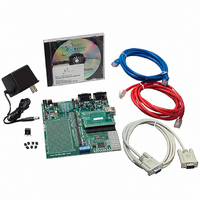NNDK-MOD5272-KIT NetBurner Inc, NNDK-MOD5272-KIT Datasheet - Page 94

NNDK-MOD5272-KIT
Manufacturer Part Number
NNDK-MOD5272-KIT
Description
KIT DEVELOP NETWORK FOR MOD5272
Manufacturer
NetBurner Inc
Series
ColdFire®r
Datasheets
1.MOD5272-100IR.pdf
(2 pages)
2.MOD5272-100IR.pdf
(550 pages)
3.NNDK-MOD5282-KIT.pdf
(2 pages)
Specifications of NNDK-MOD5272-KIT
Main Purpose
*
Embedded
*
Utilized Ic / Part
MOD5272
Primary Attributes
*
Secondary Attributes
*
Processor To Be Evaluated
MOD5272
Interface Type
RS-232, RS-485, USB
Lead Free Status / RoHS Status
Contains lead / RoHS non-compliant
Lead Free Status / RoHS Status
Lead free / RoHS Compliant, Contains lead / RoHS non-compliant
Other names
528-1001
- Current page: 94 of 550
- Download datasheet (6Mb)
Exception Processing Overview
2.8 Exception Processing Overview
Exception processing for ColdFire processors is streamlined for performance. Differences
from previous M68000 Family processors include the following:
ColdFire processors use an instruction restart exception model but require more software
support to recover from certain access errors. See Table 2-18 for details.
Exception processing can be defined as the time from the detection of the fault condition
until the fetch of the first handler instruction has been initiated. It is comprised of the
following four major steps:
2-26
• A simplified exception vector table
• Reduced relocation capabilities using the vector base register
• A single exception stack frame format
• Use of a single, self-aligning system stack pointer
1. The processor makes an internal copy of the SR and then enters supervisor mode by
2. The processor determines the exception vector number. For all faults except
3. The processor saves the current context by creating an exception stack frame on the
4. The processor acquires the address of the first instruction of the exception handler.
setting SR[S] and disabling trace mode by clearing SR[T]. The occurrence of an
interrupt exception also forces SR[M] to be cleared and the interrupt priority mask
to be set to the level of the current interrupt request.
interrupts, the processor performs this calculation based on the exception type. For
interrupts, the processor performs an interrupt-acknowledge (IACK) bus cycle to
obtain the vector number from a peripheral device. The IACK cycle is mapped to a
special acknowledge address space with the interrupt level encoded in the address.
system stack. ColdFire processors support a single stack pointer in the A7 address
register; therefore, there is no notion of separate supervisor and user stack pointers.
As a result, the exception stack frame is created at a 0-modulo-4 address on the top
of the current system stack. Additionally, the processor uses a simplified
fixed-length stack frame for all exceptions. The exception type determines whether
the program counter in the exception stack frame defines the address of the faulting
instruction (fault) or of the next instruction to be executed (next).
The exception vector table is aligned on a 1-Mbyte boundary. This instruction
address is obtained by fetching a value from the table at the address defined in the
vector base register. The index into the exception table is calculated as
Opcode
bcc
Table 2-17. Bcc Instruction Execution Times
Forward Taken
3(0/0)
MCF5272 User’s Manual
Forward Not
Taken
1(0/0)
Backward Taken
2(0/0)
Backward Not
Taken
3(0/0)
MOTOROLA
Related parts for NNDK-MOD5272-KIT
Image
Part Number
Description
Manufacturer
Datasheet
Request
R

Part Number:
Description:
BOARD SERIAL-ETHERNET 512K FLASH
Manufacturer:
NetBurner Inc
Datasheet:

Part Number:
Description:
PROCESSOR MODULE FLASH MOD5272
Manufacturer:
NetBurner Inc
Datasheet:

Part Number:
Description:
PROCESSOR MODULE 512KB FLASH
Manufacturer:
NetBurner Inc
Datasheet:

Part Number:
Description:
DUAL PORT SERIAL-ETHERNET
Manufacturer:
NetBurner Inc
Datasheet:

Part Number:
Description:
PROCESSOR MODULE FLASH
Manufacturer:
NetBurner Inc
Datasheet:

Part Number:
Description:
PROCESSOR MODULE 512KB FLASH
Manufacturer:
NetBurner Inc
Datasheet:

Part Number:
Description:
MOD5234 10/100 ETHERNET MODULE
Manufacturer:
NetBurner Inc
Datasheet:

Part Number:
Description:
KIT DEVELOP NETWORK FOR MOD5282
Manufacturer:
NetBurner Inc
Datasheet:

Part Number:
Description:
DUAL PORT SERIAL-ETHERNET
Manufacturer:
NetBurner Inc
Datasheet:

Part Number:
Description:
Ethernet Modules & Development Tools 32 Bit 66MHz 40 Pin DIP Industrial Temp
Manufacturer:
NetBurner Inc
Datasheet:

Part Number:
Description:
Ethernet Modules & Development Tools MOD5213 DEVELOPMENT KIT
Manufacturer:
NetBurner Inc

Part Number:
Description:
Ethernet Modules & Development Tools DUAL PORT SERIAL EHTERNET DEVICE
Manufacturer:
NetBurner Inc
Datasheet:

Part Number:
Description:
Ethernet ICs 32bit 147MHz CAN-to- Ethnt Device IndTemp
Manufacturer:
NetBurner Inc
Datasheet:










